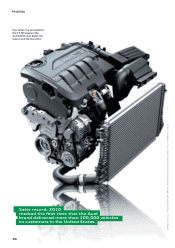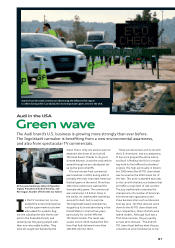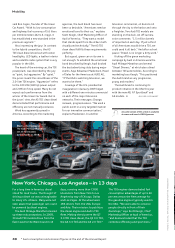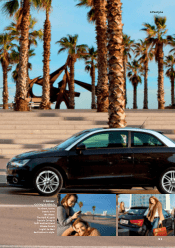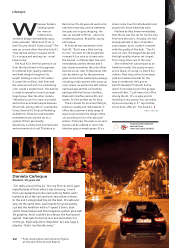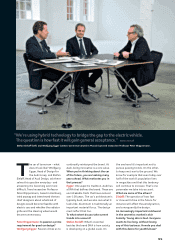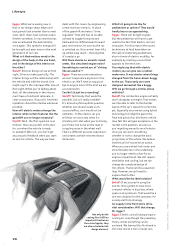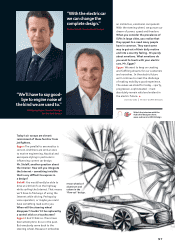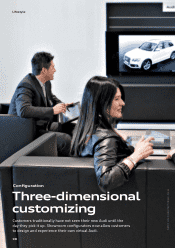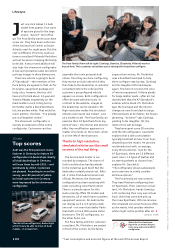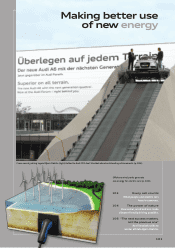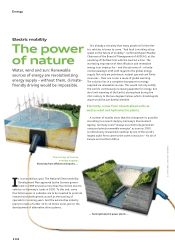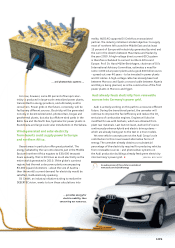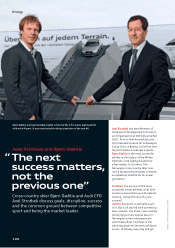Audi 2010 Annual Report Download - page 98
Download and view the complete annual report
Please find page 98 of the 2010 Audi annual report below. You can navigate through the pages in the report by either clicking on the pages listed below, or by using the keyword search tool below to find specific information within the annual report.
Egger: What we’re seeing now is
that in car design sharp edges and
taut panels look smarter than curved
ones. Such clean, taut surfaces seem
fresher somehow. In my view this has
also accentuated the Audi identity
once again. This symbolic energy will
be brought out even more in the next
generation of our cars.
What is it that matters most in the
design of the body on the one hand,
and in the design of the interior on
the other?
Sielaff : Exterior design is love at fi rst
sight. It has to make sparks fl y. The
interior brings out the relationship with
the vehicle and with the brand. One
might say it’s the marriage after love at
fi rst sight. When you’re talking about
Audi, all the elements in the interior
must have a functional rationale. A
clear-cut purpose, if you will. And their
operation should be intuitive whenever
possible.
How will electric motors change the
interior when certain features like the
gearshift are no longer necessary?
Sielaff : Well, the fi rst question is as
follows: How can you tell in the elec-
tric car when the vehicle is ready
to operate? After all, you don’t get
any acoustic feedback when you start
an electric vehicle. The way we have
dealt with this now is by engineering
a neat start-up scenario. In place
of the gearshift we have a “drive
regulator” that still has to be able
at least to toggle forwards and
backwards to shift between forward
gear and reverse. As soon as the car
is switched on, this control lever tilts
up within easy reach – showing that
it’s ready to go.
Will there also be an acoustic mood-
setter, like simulated engine noise?
Something to remind you of “driving
like we used to”?
Egger: There are some sensations
we won’t experience anymore in the
electric car. We’ll have to say good-
bye to engine noise of the kind we are
accustomed to.
Couldn’t it just be a recording?
Sielaff : Technically that would be
possible, but is it really credible?
It’s almost a philosophical question
whether one should create such
a sound eff ect, as it would not be
authentic. In the electric car you
will hear no noise only when it’s
standing still. But when you’re driving,
you’ll hear tire noise on the road or
a rippling noise in the wheel well.
That’s a diff erent acoustic experience
and creates a whole new emotional
dimension.
What’s it going to be like for
pedestrians or cyclists? They would
hardly hear a car approaching.
Egger: There will be light signals.
But the pedestrian will have to get
used to the fact that electric cars are
very quiet. For this reason the sound
technicians at Audi have taken on
the task of protecting pedestrians
also in times of electric mobility, for
example by creating a sound that
appeals to the emotions.
You might say that with electric
motors you can give cars a radical
make-over. It was similar when things
changed from the horse-drawn buggy
to the car. Those early cars were
designed somewhat like a buggy.
Will we go through a similar phase
with this?
Sielaff : The combustion engine certainly
won’t disappear overnight. That means
we’ll be able to refer to the familiar
basics of the car’s layout for some time
yet. Especially since we are using hybrid
technology to bridge the gap to the
fi nal end point of an all-electric vehicle.
How fast this will gain acceptance in the
market is the question. As soon as
you’re getting around to an all-electric
drive you can start considering
whether or not to change the basic
proportions of the vehicle. We believe
that this will of course be an option.
When you use a wheel-hub motor and
stow the batteries in the underbody
you no longer need to allow for an
engine compartment. We still require
ventilation and cooling, but we can
change the complete design of
the vehicle. That would be a quantum
leap. However, we still need to
explore that further.
What would be the ideal solution?
Sielaff : If we succeed in using the
electric drive system to have more
compact vehicles in big cities, where
space is at a premium. That would be a
win-win situation for the customer, for
society and for technology.
Air supply in the front end is still a
vital consideration. Will that change,
Mr. Egger?
Egger: Electric cars will always require
cooling air, even though the prevailing
theory is that everything can be
enclosed. We learned this fi rst-hand in
the most recent e-tron concept cars.
Lifestyle
Not only do the
cooling fi ns fulfi ll an
important function on
the e-tron Spyder, they
are also a characteristic
design element.
96
SKETCHES | AUDI AG (2) PHOTOS | JAN RIEPHOFF/TANK MANAGEMENT; FRANK BAUER/GETTY IMAGES


